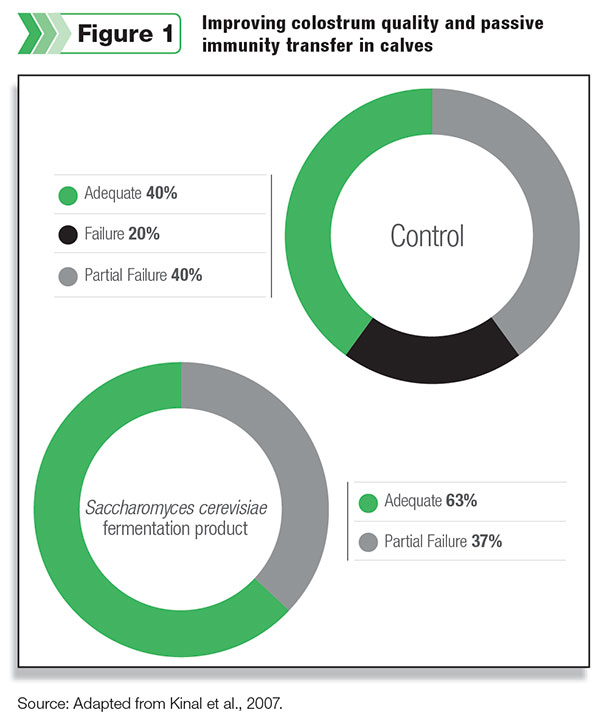Keeping newborn calves dry and cows’ udders clean goes a long way toward reducing scours. Moreover, should we get a case of scours, a dry, clean environment is a huge asset when it comes to preventing other calves from getting sick.
But let’s back up a bit. Although our first calves may not be dropping until March, we can begin preventing calf scours in January.
To reduce calf scours,why start with the cow?
At birth, the newborn calf’s immune system is relatively undeveloped. That’s why it’s so essential that the calf consume an adequate amount of high-quality colostrum from the cow as soon as possible after birth.
Colostrum contains antibodies or immunoglobulins that essentially provide all of the protection the newborn calf is going to get until its own immune system becomes fully developed months later. Colostrum is the vehicle for what we refer to as “passive transfer of immunity” from the cow to her calf.
Adequate passive transfer of immunity goes a long, long way when it comes to preventing calf scours. Calf health suffers when we have a failure of passive transfer. Failure of passive transfer can occur when we have poor colostrum quality, inadequate colostrum intake or there is a delay in the consumption of colostrum.
Failure of passive transfer is not something we can “see” in a beef calf without a blood sample in order to measure serum immunoglobulin levels. However, blood sampling is generally impractical for most beef operations. Therefore, we must do whatever we can to minimize the incidence of failure of passive transfer.
Research has shown severe consequences as a result of failure of passive transfer. Research from the Meat Animal Research Center in Clay Center, Nebraska, indicated that calves with low serum immunoglobulin levels were 5.4 times more likely to die before weaning. Also, calves were 3.2 times more likely to get sick.
Note that the researchers expressed the risk as “times” and not “percent” more likely. When you think about it, this is not a risk you want to take – especially at today’s calf prices.
How can we improve passive transfer of immunity?
Colostrum quality is the place to start. We can have an effect on colostrum quality depending on how we feed and manage the pregnant dam running up to calving.
First, we need to ensure we have cows at an ideal body condition score (5-6) during this time so that digestible feed resources are not having to be directed toward putting on condition.
Adequate levels of dietary energy and protein are probably most critical, but we also want to be sure we are meeting the mineral and vitamin needs of cows. There are simply too many roles specific micronutrients play within the immune system; we cannot overlook them.
Essential micronutrients also are used in fetal development and are passed through the colostrum and milk to newborn calves.
In addition, research shows that an all-natural, Saccharomyces cerevisiae fermentation product improves colostrum quality as measured by colostrum immunoglobulin levels.

In short, if we take good care of the cow, then we increase our chances of her producing high-quality colostrum and we reduce our risk of failure of passive transfer (Figure 1).
Calf intake of colostrum is perhaps a little trickier. Obviously, first-calf heifers are likely to produce a little less colostrum than cows in their prime. Genetics also plays a role in how much colostrum cows produce.
However, if we supply adequate nutrients for what the cow needs to produce high-quality colostrum, then it makes sense that those same nutrients will be utilized to produce an amount of colostrum that is optimum for her age and genetic potential.
Timeliness of colostrum intake directly relates to ease of calving. Typically, the longer a cow is in labor, the longer it takes for that calf to get up and sucking.
Your bets are already placed in terms of what sires you utilized and their ability to sire calves that come easily. However, calving ease could be something to keep in mind this summer when turning bulls out or perhaps even now when you’re looking to purchase herd bulls for next season.
Anyhow, if we feed to maintain our cows at an optimum body condition, then we should expect less dystocia. Then calves should be up and nursing within a couple hours of birth – when colostrum is most valuable to the calf.
When should we begin helping the cow to reduce scours in her calf?
Now is the time to take a look at your brood cow feeding program in order to minimize the risk of calf scours. You’re going to want to leave yourself some time if you have a few thin cows or heifers that need extra nutrients.
Don’t be reluctant to sort them off and feed them separately. Overconditioned cows deserve your attention, too, although this challenge tends to be less common.
In order to build up mineral reserves in the dam’s body, and for colostrum quality to be improved by a fermentation product, you’ll need to allow yourself a minimum of six to eight weeks feeding prior to calving.
We need to keep in mind what’s at stake
Remember that calf scours is often deadly and that prevention is always our best option. The value of calves these days makes scours prevention a top priority.
Taking care of our cows to help prevent calf scours a couple months down the road also provides numerous other benefits to both the cow and her calf. Those benefits range from fewer incidences of calving problems to improved breed-back.
The benefits of good cow care far outweigh the cost. The end results are productive cows and healthy calves, year after year. ![]()
References omitted due to space but are available upon request. Click here to email an editor.

- Craig Belknap
- Beef Field Technical Specialist
- Diamond V








